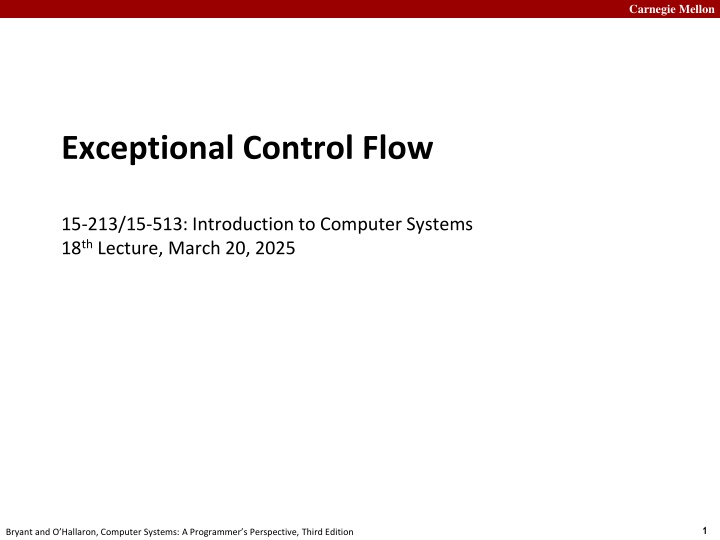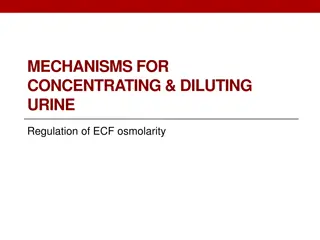
Control Flow in Computer Systems: Understanding Altering Mechanisms
Explore the concept of control flow in computer systems as discussed in Carnegie Mellon University lectures. Discover how processors execute instructions, prevent resource accumulation in shells, and address exceptional control flow scenarios. Gain insights on managing control flow alterations to enhance system efficiency and stability.
Download Presentation

Please find below an Image/Link to download the presentation.
The content on the website is provided AS IS for your information and personal use only. It may not be sold, licensed, or shared on other websites without obtaining consent from the author. If you encounter any issues during the download, it is possible that the publisher has removed the file from their server.
You are allowed to download the files provided on this website for personal or commercial use, subject to the condition that they are used lawfully. All files are the property of their respective owners.
The content on the website is provided AS IS for your information and personal use only. It may not be sold, licensed, or shared on other websites without obtaining consent from the author.
E N D
Presentation Transcript
Carnegie Mellon Exceptional Control Flow 15-213/15-513: Introduction to Computer Systems 18thLecture, March 20, 2025 1 Bryant and O Hallaron, Computer Systems: A Programmer s Perspective, Third Edition
Carnegie Mellon Today Exceptional Control Flow Exceptions Signals If we have time: Nonlocal Jumps 3 Bryant and O Hallaron, Computer Systems: A Programmer s Perspective, Third Edition
Carnegie Mellon Problem with Simple Shell Example Shell designed to run indefinitely Should not accumulate unneeded resources Memory Child processes File descriptors Our example shell correctly waits for and reaps foreground jobs But what about background jobs? Will become zombies when they terminate Will never be reaped because shell (typically) will not terminate Could run the entire computer out of memory More likely, run out of PIDs 4 Bryant and O Hallaron, Computer Systems: A Programmer s Perspective, Third Edition
Carnegie Mellon Printers Used to Catch on Fire 5 Bryant and O Hallaron, Computer Systems: A Programmer s Perspective, Third Edition
Carnegie Mellon Highly Exceptional Control Flow https://git.kernel.org/pub/scm/linux/kernel/git/torvalds/linux.git/tree/drivers/char/lp.c?h=v5.0-rc3 6 Bryant and O Hallaron, Computer Systems: A Programmer s Perspective, Third Edition
Carnegie Mellon Control Flow Processors do only one thing: From startup to shutdown, each CPU core simply reads and executes (interprets) a sequence of instructions, one at a time * This sequence is the CPU s control flow (or flow of control) Physical control flow <startup> inst1 inst2 inst3 instn <shutdown> Time * Externally, from an architectural viewpoint (internally, the CPU may use parallel out-of-order execution) 7 Bryant and O Hallaron, Computer Systems: A Programmer s Perspective, Third Edition
Carnegie Mellon Altering the Control Flow Up to now: two mechanisms for changing control flow: Jumps and branches Call and return React to changes in program state Insufficient for a useful system: Difficult to react to changes in system state Data arrives from a disk or a network adapter Instruction divides by zero User hits Ctrl-C at the keyboard System timer expires System needs mechanisms for exceptional control flow 8 Bryant and O Hallaron, Computer Systems: A Programmer s Perspective, Third Edition
Carnegie Mellon Exceptional Control Flow Exists at all levels of a computer system Low level mechanisms 1. Exceptions Change in control flow in response to a system event (i.e., change in system state) Implemented using combination of hardware and OS software Higher level mechanisms 2. Process context switch Implemented by OS software and hardware timer 3. Signals Implemented by OS software 4. Nonlocal jumps: setjmp() and longjmp() Implemented by C runtime library 9 Bryant and O Hallaron, Computer Systems: A Programmer s Perspective, Third Edition
Carnegie Mellon Today Exceptional Control Flow Exceptions Signals If we have time: Nonlocal Jumps 10 Bryant and O Hallaron, Computer Systems: A Programmer s Perspective, Third Edition
Carnegie Mellon Exceptions An exception is a transfer of control to the OS kernel in response to some event (i.e., change in processor state) Kernel is the memory-resident part of the OS Examples of events: Divide by 0, arithmetic overflow, page fault, I/O request completes, typing Ctrl-C User code Kernel code Exception Event I_current I_next Exception processing by exception handler Return to I_current Return to I_next Abort 11 Bryant and O Hallaron, Computer Systems: A Programmer s Perspective, Third Edition
Carnegie Mellon Exception Tables Exception numbers Each type of event has a unique exception number k Code for exception handler 0 Exception Table Code for exception handler 1 k = index into exception table (a.k.a. interrupt vector) 0 1 2 Code for exception handler 2 ... n-1 Handler k is called each time exception k occurs ... Code for exception handler n-1 12 Bryant and O Hallaron, Computer Systems: A Programmer s Perspective, Third Edition
Carnegie Mellon Taxonomy of Hardware ECF ECF Asynchronous Synchronous Interrupts Traps Faults Aborts 13 Bryant and O Hallaron, Computer Systems: A Programmer s Perspective, Third Edition
Carnegie Mellon Asynchronous Exceptions (Interrupts) Caused by events external to the processor Indicated by setting the processor s interrupt pin Handler returns to next instruction Examples: Timer interrupt Every few ms, an external timer chip triggers an interrupt Used by the kernel to take back control from user programs I/O interrupt from external device Hitting Ctrl-C at the keyboard Arrival of a packet from a network Arrival of data from a disk 14 Bryant and O Hallaron, Computer Systems: A Programmer s Perspective, Third Edition
Carnegie Mellon Synchronous Exceptions Caused by events that occur as a result of executing an instruction: Traps Intentional, set program up to trip the trap and do something Examples: system calls, gdb breakpoints Returns control to next instruction Faults Unintentional but possibly recoverable Examples: page faults (recoverable), protection faults (unrecoverable), floating point exceptions Either re-executes faulting ( current ) instruction or aborts Aborts Unintentional and unrecoverable Examples: illegal instruction, parity error, machine check Aborts current program 15 Bryant and O Hallaron, Computer Systems: A Programmer s Perspective, Third Edition
Carnegie Mellon System Calls Each x86-64 system call has a unique ID number Examples: Number Name read write open close stat fork execve _exit kill Description 0 Read file 1 Write file 2 Open file 3 Close file 4 Get info about file 57 Create process 59 Execute a program 60 Terminate process 62 Send signal to process 16 Bryant and O Hallaron, Computer Systems: A Programmer s Perspective, Third Edition
Carnegie Mellon System Call Example: Opening File User calls: open(filename, options) Calls __open function, which invokes system call instruction syscall 00000000000e5d70 <__open>: ... e5d79: b8 02 00 00 00 mov $0x2,%eax # open is syscall #2 e5d7e: 0f 05 syscall # Return value in %rax e5d80: 48 3d 01 f0 ff ff cmp $0xfffffffffffff001,%rax ... e5dfa: c3 retq User code Kernel code %rax contains syscall number Other arguments in %rdi, %rsi, %rdx, %r10, %r8, %r9 Exception syscall cmp Return value in %rax Open file Negative value is an error corresponding to negative errno Returns 17 Bryant and O Hallaron, Computer Systems: A Programmer s Perspective, Third Edition
Carnegie Mellon System Call Example: Opening File Almost like a function call Transfer of control On return, executes next instruction Passes arguments using calling convention Gets result in %rax User calls: open(filename, options) Calls __open function, which invokes system call instruction syscall 00000000000e5d70 <__open>: ... e5d79: b8 02 00 00 00 mov $0x2,%eax # open is syscall #2 e5d7e: 0f 05 syscall # Return value in %rax e5d80: 48 3d 01 f0 ff ff cmp $0xfffffffffffff001,%rax ... e5dfa: c3 retq Different set of privileges And other differences: E.g., address of function is in %rax Uses errno Etc. One Important exception! Executed by Kernel User code Kernel code %rax contains syscall number Other arguments in %rdi, %rsi, %rdx, %r10, %r8, %r9 Exception syscall cmp Return value in %rax Open file Negative value is an error corresponding to negative errno Returns 18 Bryant and O Hallaron, Computer Systems: A Programmer s Perspective, Third Edition
Carnegie Mellon Fault Example: Page Fault int a[1000]; main () { a[500] = 13; } User writes to memory location That portion (page) of user s memory is currently on disk 80483b7: c7 05 10 9d 04 08 0d movl $0xd,0x8049d10 User code Kernel code Exception: page fault movl Copy page from disk to memory Return and reexecute movl 19 Bryant and O Hallaron, Computer Systems: A Programmer s Perspective, Third Edition
Carnegie Mellon Fault Example: Invalid Memory Reference int a[1000]; main () { a[5000] = 13; } 80483b7: c7 05 60 e3 04 08 0d movl $0xd,0x804e360 User code Kernel code Exception: page fault movl Detect invalid address Signal process Sends SIGSEGV signal to user process User process exits with segmentation fault 20 Bryant and O Hallaron, Computer Systems: A Programmer s Perspective, Third Edition
Carnegie Mellon Quiz https://canvas.cmu.edu/courses/37116/quizzes/109925 21 Bryant and O Hallaron, Computer Systems: A Programmer s Perspective, Third Edition
Carnegie Mellon Today Exceptional Control Flow Exceptions Signals If we have time: Nonlocal Jumps 22 Bryant and O Hallaron, Computer Systems: A Programmer s Perspective, Third Edition
Carnegie Mellon ECF Exists at All Levels of a System Exceptions Hardware and operating system kernel software Process Context Switch Hardware timer and kernel software Signals Kernel software and application software Nonlocal jumps Application code 23 Bryant and O Hallaron, Computer Systems: A Programmer s Perspective, Third Edition
Carnegie Mellon Problem with Simple Shell Example Shell designed to run indefinitely Should not accumulate unneeded resources Memory Child processes File descriptors Our example shell correctly waits for and reaps foreground jobs But what about background jobs? Will become zombies when they terminate Will never be reaped because shell (typically) will not terminate Will create a memory leak that could run the kernel out of memory 24 Bryant and O Hallaron, Computer Systems: A Programmer s Perspective, Third Edition
Carnegie Mellon ECF to the Rescue! Solution: Exceptional control flow The kernel will interrupt regular processing to alert us when a background process completes In Unix, the alert mechanism is called a signal 25 Bryant and O Hallaron, Computer Systems: A Programmer s Perspective, Third Edition
Carnegie Mellon Signals A signal is a small message that notifies a process that an event of some type has occurred in the system Akin to exceptions and interrupts Sent from the kernel (sometimes at the request of another process) to a process Signal type is identified by small integer ID s (1-30) Only information in a signal is its ID and the fact that it arrived ID Name 2 SIGINT 9 SIGKILL 11 SIGSEGV 14 SIGALRM 17 SIGCHLD Default Action Terminate Terminate Terminate Terminate Ignore Corresponding Event User typed ctrl-c Kill program (cannot override or ignore) Segmentation violation Timer signal Child stopped or terminated 26 Bryant and O Hallaron, Computer Systems: A Programmer s Perspective, Third Edition
Carnegie Mellon Signal Concepts: Sending a Signal Kernel sends a signal to a destination process by updating some state in the context of the destination process Kernel sends a signal for one of the following reasons: Kernel has detected a system event such as divide-by-zero (SIGFPE) or the termination of a child process (SIGCHLD) Another process has invoked the kill system call to explicitly request the kernel to send a signal to the destination process 27 Bryant and O Hallaron, Computer Systems: A Programmer s Perspective, Third Edition
Carnegie Mellon Signal Concepts: Sending a Signal User level Process B Process A Process C kernel Pending for A Pending for B Pending for C Blocked for A Blocked for B Blocked for C 28 Bryant and O Hallaron, Computer Systems: A Programmer s Perspective, Third Edition
Carnegie Mellon Signal Concepts: Sending a Signal User level Process B Process A Process C kernel Pending for A Pending for B Pending for C Blocked for A Blocked for B Blocked for C 29 Bryant and O Hallaron, Computer Systems: A Programmer s Perspective, Third Edition
Carnegie Mellon Signal Concepts: Sending a Signal User level Process B Process A Process C kernel Pending for A Pending for B Pending for C Blocked for A Blocked for B Blocked for C 1 30 Bryant and O Hallaron, Computer Systems: A Programmer s Perspective, Third Edition
Carnegie Mellon Signal Concepts: Sending a Signal User level Process B Process A Process C kernel Pending for A Pending for B Pending for C Blocked for A Blocked for B Blocked for C 1 31 Bryant and O Hallaron, Computer Systems: A Programmer s Perspective, Third Edition
Carnegie Mellon Signal Concepts: Sending a Signal User level Process B Process A Process C kernel Pending for A Pending for B Pending for C Blocked for A Blocked for B Blocked for C 0 32 Bryant and O Hallaron, Computer Systems: A Programmer s Perspective, Third Edition
Carnegie Mellon Signal Concepts: Receiving a Signal A destination process receives a signal when it is forced by the kernel to react in some way to the signal Some possible ways to react: Ignore the signal (do nothing) Terminate the process (with optional core dump) Catchthe signal by executing a user-level function called signal handler Akin to a hardware exception handler being called in response to an asynchronous interrupt: (1) Signal received by process (2) Control passes to signal handler Icurr Inext (3) Signal handler runs (4) Signal handler returns to next instruction 33 Bryant and O Hallaron, Computer Systems: A Programmer s Perspective, Third Edition
Carnegie Mellon Signal Concepts: Pending and Blocked Signals A signal is pending if sent but not yet received There can be at most one pending signal of each type Important: Signals are not queued If a process has a pending signal of type k, then subsequent signals of type k that are sent to that process are discarded A process can block the receipt of certain signals Blocked signals can be sent, but will not be received until the signal is unblocked Some signals cannot be blocked (SIGKILL, SIGSTOP) or can only be blocked when sent by other processes (SIGSEGV, SIGILL, etc) A pending signal is received at most once 34 Bryant and O Hallaron, Computer Systems: A Programmer s Perspective, Third Edition
Carnegie Mellon Signal Concepts: Pending/Blocked Bits Kernel maintains pending and blocked bit vectors in the context of each process pending: represents the set of pending signals Kernel sets bit k in pending when a signal of type k is sent Kernel clears bit k in pending when a signal of type k is received blocked: represents the set of blocked signals Can be set and cleared by using the sigprocmask function Also referred to as the signal mask. 35 Bryant and O Hallaron, Computer Systems: A Programmer s Perspective, Third Edition
Carnegie Mellon Signal Concepts: Sending a Signal User level Process B Process A Process C kernel Pending for A Pending for B Pending for C Blocked for A Blocked for B Blocked for C 1 36 Bryant and O Hallaron, Computer Systems: A Programmer s Perspective, Third Edition
Carnegie Mellon Sending Signals: Process Groups Every process belongs to exactly one process group pid=10 pgid=10 Shell Back- ground job #1 Fore- ground job Back- ground job #2 pid=20 pgid=20 pid=32 pgid=32 pid=40 pgid=40 Background process group 32 Background process group 40 Child Child getpgrp() Return process group of current process pid=21 pgid=20 pid=22 pgid=20 Foreground process group 20 setpgid() Change process group of a process (see text for details) 37 Bryant and O Hallaron, Computer Systems: A Programmer s Perspective, Third Edition
Carnegie Mellon Sending Signals with /bin/kill Program /bin/kill program sends arbitrary signal to a process or process group linux> ./forks 16 Child1: pid=24818 pgrp=24817 Child2: pid=24819 pgrp=24817 linux> ps PID TTY TIME CMD 24788 pts/2 00:00:00 tcsh 24818 pts/2 00:00:02 forks 24819 pts/2 00:00:02 forks 24820 pts/2 00:00:00 ps linux> /bin/kill -9 -24817 linux> ps PID TTY TIME CMD 24788 pts/2 00:00:00 tcsh 24823 pts/2 00:00:00 ps linux> Examples /bin/kill 9 24818 Send SIGKILL to process 24818 /bin/kill 9 24817 Send SIGKILL to every process in process group 24817 38 Bryant and O Hallaron, Computer Systems: A Programmer s Perspective, Third Edition
Carnegie Mellon Sending Signals from the Keyboard Typing ctrl-c (ctrl-z) causes the kernel to send a SIGINT (SIGTSTP) to every job in the foreground process group SIGINT default action is to terminate each process SIGTSTP default action is to stop (suspend) each process pid=10 pgid=10 Shell Back- ground job #1 Fore- ground job Back- ground job #2 pid=20 pgid=20 pid=32 pgid=32 pid=40 pgid=40 Background process group 32 Background process group 40 Child Child pid=21 pgid=20 pid=22 pgid=20 Foreground Bryant and O Hallaron, Computer Systems: A Programmer s Perspective, Third Edition process group 20 39
Carnegie Mellon Example of ctrl-c and ctrl-z STAT (process state) Legend: bluefish> ./forks 17 Child: pid=28108 pgrp=28107 Parent: pid=28107 pgrp=28107 <types ctrl-z> Suspended bluefish> ps w PID TTY STAT TIME COMMAND 27699 pts/8 Ss 0:00 -tcsh 28107 pts/8 T 0:01 ./forks 17 28108 pts/8 T 0:01 ./forks 17 28109 pts/8 R+ 0:00 ps w bluefish> fg ./forks 17 <types ctrl-c> bluefish> ps w PID TTY STAT TIME COMMAND 27699 pts/8 Ss 0:00 -tcsh 28110 pts/8 R+ 0:00 ps w First letter: S: sleeping T: stopped R: running Second letter: s: session leader +: foreground proc group See man ps for more details 40 Bryant and O Hallaron, Computer Systems: A Programmer s Perspective, Third Edition
Carnegie Mellon Sending Signals with kill Function void fork12() { pid_t pid[N]; int i; int child_status; for (i = 0; i < N; i++) if ((pid[i] = fork()) == 0) { /* Child: Infinite Loop */ while(1) ; } for (i = 0; i < N; i++) { printf("Killing process %d\n", pid[i]); kill(pid[i], SIGINT); } for (i = 0; i < N; i++) { pid_t wpid = wait(&child_status); if (WIFEXITED(child_status)) printf("Child %d terminated with exit status %d\n", wpid, WEXITSTATUS(child_status)); else printf("Child %d terminated abnormally\n", wpid); } } forks.c 41 Bryant and O Hallaron, Computer Systems: A Programmer s Perspective, Third Edition
Carnegie Mellon Receiving Signals Suppose kernel is returning from an exception handler and is ready to pass control to process p Process q Process p user code context switch kernel code Time user code context switch kernel code user code 42 Bryant and O Hallaron, Computer Systems: A Programmer s Perspective, Third Edition
Carnegie Mellon Receiving Signals Suppose kernel is returning from an exception handler and is ready to pass control to process p Kernel computes pnb = pending & ~blocked The set of pending nonblocked signals for process p If (pnb == 0) Pass control to next instruction in the logical flow for p Else Choose least nonzero bit k in pnb and force process p to receive signal k The receipt of the signal triggers some action by p Repeat for all nonzero k in pnb Pass control to next instruction in logical flow for p 43 Bryant and O Hallaron, Computer Systems: A Programmer s Perspective, Third Edition
Carnegie Mellon Default Actions Each signal type has a predefined default action, which is one of: The process terminates The process stops until restarted by a SIGCONT signal The process ignores the signal 44 Bryant and O Hallaron, Computer Systems: A Programmer s Perspective, Third Edition
Carnegie Mellon Installing Signal Handlers The signal function modifies the default action associated with the receipt of signal signum: handler_t *signal(int signum, handler_t *handler) Different values for handler: SIG_IGN: ignore signals of type signum SIG_DFL: revert to the default action on receipt of signals of type signum Otherwise, handler is the address of a user-level signal handler Called when process receives signal of type signum Referred to as installing the handler Executing handler is called catching or handling the signal When the handler executes its return statement, control passes back to instruction in the control flow of the process that was interrupted by receipt of the signal 45 Bryant and O Hallaron, Computer Systems: A Programmer s Perspective, Third Edition
Carnegie Mellon Signal Handling Example void sigint_handler(int sig) /* SIGINT handler */ { printf("So you think you can stop the bomb with ctrl-c, do you?\n"); sleep(2); printf("Well..."); fflush(stdout); sleep(1); printf("OK. :-)\n"); exit(0); } int main(int argc, char** argv) { /* Install the SIGINT handler */ if (signal(SIGINT, sigint_handler) == SIG_ERR) unix_error("signal error"); /* Wait for the receipt of a signal */ pause(); return 0; } sigint.c 46 Bryant and O Hallaron, Computer Systems: A Programmer s Perspective, Third Edition
Carnegie Mellon Signals Handlers as Concurrent Flows A signal handler is a separate logical flow (not process) that runs concurrently with the main program But, this flow exists only until returns to main program Process A Process A Process B while (1) ; handler(){ } Time 47 Bryant and O Hallaron, Computer Systems: A Programmer s Perspective, Third Edition
Carnegie Mellon Another View of Signal Handlers as Concurrent Flows Process A Process B user code (main) Signal sent to process A Icurr context switch kernel code user code (main) context switch kernel code Signal received by process A user code (handler) kernel code Inext user code (main) 48 Bryant and O Hallaron, Computer Systems: A Programmer s Perspective, Third Edition
Carnegie Mellon Nested Signal Handlers Handlers can be interrupted by other handlers Main program Handler S Handler T (2) Control passes to handler S (1) Program catches signal s Icurr (4) Control passes to handler T (3) Program catches signal t Inext (7) Main program resumes (5) Handler T returns to handler S (6) Handler S returns to main program 49 Bryant and O Hallaron, Computer Systems: A Programmer s Perspective, Third Edition
Carnegie Mellon Blocking and Unblocking Signals Implicit blocking mechanism Kernel blocks any pending signals of type currently being handled e.g., a SIGINT handler can t be interrupted by another SIGINT Explicit blocking and unblocking mechanism sigprocmask function Supporting functions sigemptyset Create empty set sigfillset Add every signal number to set sigaddset Add signal number to set sigdelset Delete signal number from set 50 Bryant and O Hallaron, Computer Systems: A Programmer s Perspective, Third Edition
Carnegie Mellon Temporarily Blocking Signals sigset_t mask, prev_mask; sigemptyset(&mask); sigaddset(&mask, SIGINT); /* Block SIGINT and save previous blocked set */ sigprocmask(SIG_BLOCK, &mask, &prev_mask); /* Code region that will not be interrupted by SIGINT */ /* Restore previous blocked set, unblocking SIGINT */ sigprocmask(SIG_SETMASK, &prev_mask, NULL); 51 Bryant and O Hallaron, Computer Systems: A Programmer s Perspective, Third Edition







